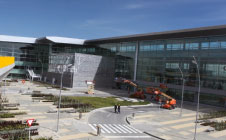
Pulido: “In modernising and expanding the terminal, we wanted to provide our passengers with greater comfort, better safety, faster and friendlier service, and more information as they journey through the airport.”
In 2012 Bogotá’s El Dorado International Airport handled nearly 310,000 national and international flights – and almost 23 million passengers – and growth shows no sign of slowing. With throughput increasing at a rapid rate, its modernisation is both well timed and well considered.
The expansion programme has already seen the rigorous rejuvenation of the airport’s existing facilities, as well as the inauguration of the state-of-the-art new International Terminal 2 in October 2012. Work is currently underway on the final phase of the project – an extension of the remodelled terminal, which will begin handling domestic flights when it is completed in July 2014. The transformed El Nuevo Dorado International Airport will undoubtedly form the largest infrastructure project in Colombia’s capital city, and, while, already one of the largest air travel hubs in South America, the airport promises to become the most modern in the region.
When OPAIN (Operadora Aeroportuaria Internacional) – a consortium of Swiss Flughafen Zürich and a number of Colombian engineering and construction companies – became operator of the airport in 2007, it was quickly decided that fulfilling the needs of the region’s multiplying passenger traffic would mean developing a new facility with enhanced amenities for airport and passenger. $1 billion (€770 million) has been invested in the elaborate modernisation and expansion project, which, with the construction of the new terminal, has seen the airport’s footprint expand from 50,000sqm to over 163,000sqm.

$1 billion (€770 million) has been invested in the modernisation and expansion project, which, with the construction of the new terminal, has seen the airport’s footprint expand from 50,000sqm to over 163,000sqm.
Juan Pulido, General Manager, OPAIN said: “In modernising and expanding the terminal we wanted to provide our passengers with greater comfort, better safety, faster and friendlier service, and more information as they journey through the airport. This requires reducing queues, introducing self-service check-in and providing real-time information along all points of the journey. We’re very happy with the progress made so far and we look forward to our next key milestone in 2014.”
The new five-storey Terminal 2 is certainly designed with the passenger experience in mind. A +44% increase in the number of immigration counters will considerably reduce waiting times for travellers, while augmented security filters have been implemented to enhance passenger comfort. In addition, the new terminal’s ‘Systematised Airport’ concept has enabled the centralisation of in-terminal air conditioning, air injection and extraction, lighting and emergency measures for operational efficiency. An automated lighting system that reduces energy consumption and a rainfall water recycling system that reduces water usage have been installed to ensure environmentally sustainable airport activities.
As part of the programme, global air transport IT and communications specialist SITA – in collaboration with Johnson Controls – has transformed the terminal with 15 innovative passenger processing solutions. Designed to optimise infrastructure and operational efficiency, the technology has enhanced business intelligence in the terminal by automating and integrating airport processes. The airport’s airlines can now make use of the new common-use check-in and transfer counters, while passengers can utilise self-service check-in kiosks, and the baggage management system is entirely automated.
“Our new international terminal is the most technologically advanced air terminal in Colombia, thanks to SITA and Johnson Controls. Not only does it provide a gateway to our capital, Bogotá, it also serves as a symbol of the country’s desire to modernise and integrate with neighbouring nations. This makes it one of Colombia’s most important infrastructure projects,” Pulido added.







